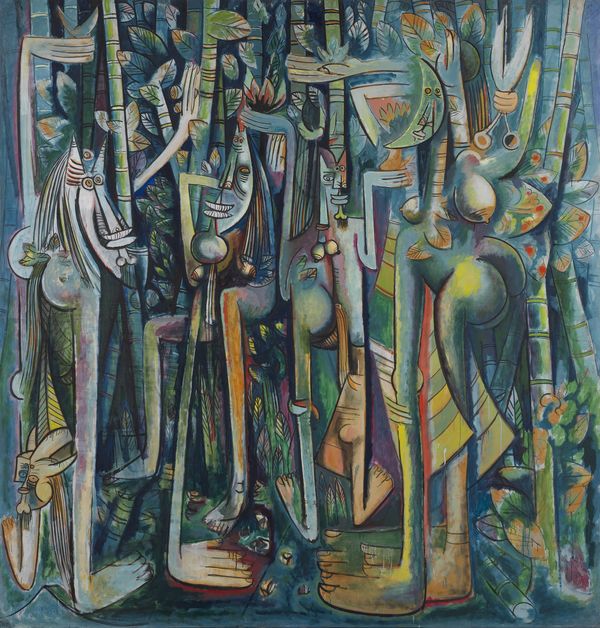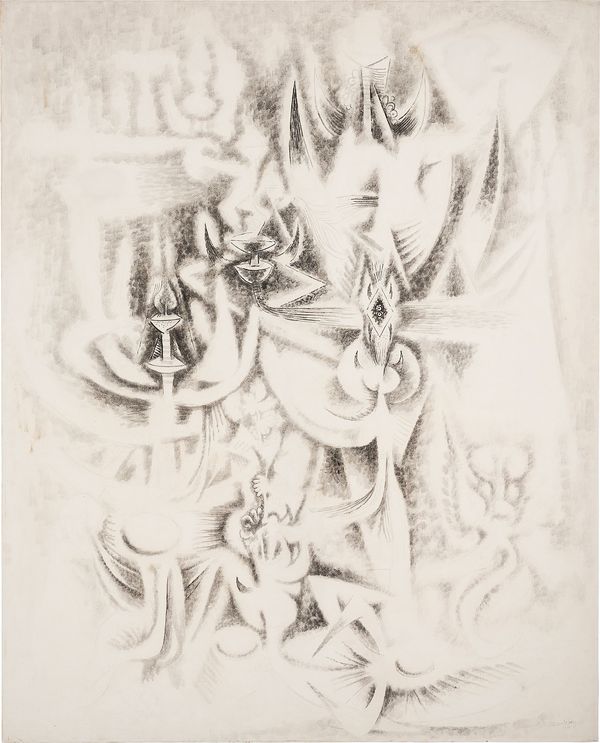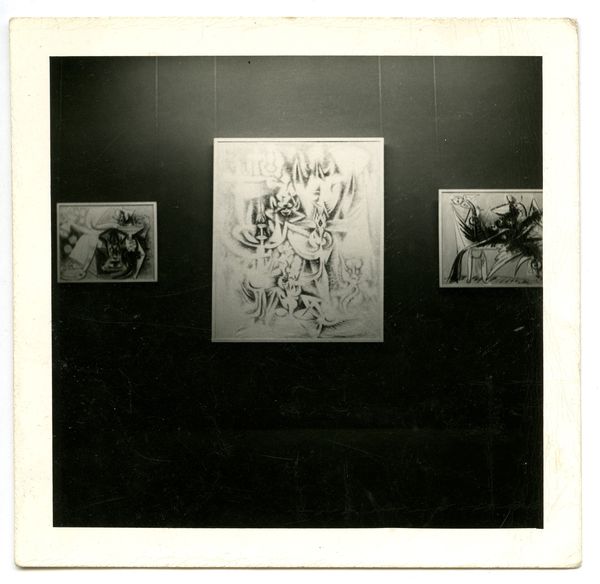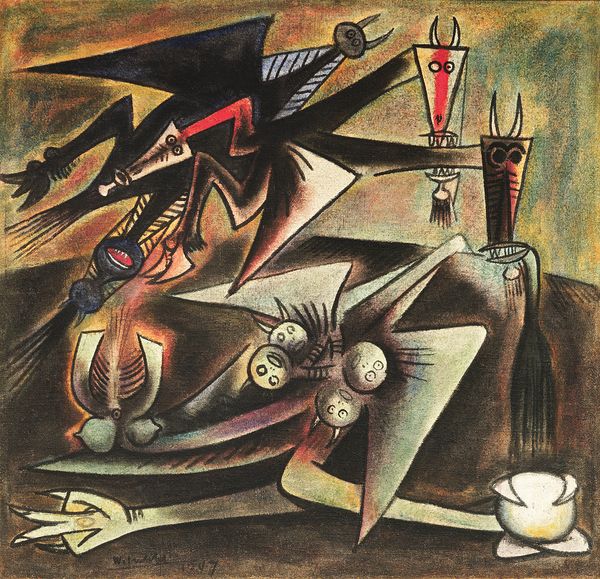Wifredo Lam Sur les traces, 1945. The work will come to auction this November in our Hong Kong Evening Sale of 20th Century & Contemporary Art.
By Abigail McEwen, PhD
A paradigmatic Chinese Caribbean man, Wifredo Lam drew upon the wealth of his multiracial heritage—African, Cuban, Chinese—over the course of an extraordinary career that spanned five continents. The son of a Cantonese immigrant, Yam (Enrique) Lam, who decades earlier had made the journey from San Francisco through Mexico to Cuba, grew up within Havana's thriving barrio de asiáticos surrounded by Chinese family and culture. His uncle owned a restaurant—Lam knew the Chinese names of all the dishes—and his father introduced him to ancestor worship, a ritual and age-old means of cultivating loyalty and filial piety. A scribe and calligrapher for the community, Yam Lam adorned his bedroom with Confucian writings, acquainting his son with traditional ink painting and calligraphy at an early age. "Wherever he went, my father carried the memory of all sorts of landscapes: Siberia, Mongolia, Tartary, the drama of Asia and the China Sea," Lam recalled. "In his eyes, you could see the sunrise of an island in turmoil fighting for its freedom."
Not only did his father pass on his Chinese citizenship—Lam only became a Cuban national at the age of twenty-one, just before he left for Spain in late 1923—but he served as well as a conduit to the spiritual and artistic lineage of China. By the time of Lam's return to the island in 1941, amid the outbreak of the Second World War, his work had evolved in dialogue with the European avant-garde, particularly with Surrealism and its affinities with ethnography and the occult. His encounter with Africa, vis-à-vis Pablo Picasso and the culture of Black Paris, anticipated his re-engagement in Havana with "la cosa negra" and the weight of the colonial past. "My return to Cuba meant, above all, a great stimulation of my imagination, as well as the exteriorization of my world," he recounted of his homecoming. "I responded always to the presence of factors which emanated from our history and our geography, tropical flowers and black culture."
Sur les traces on view in 1945 at the Pierre Matisse Gallery, New York
At a time of surging interest in Afro-Cuban cosmology, led by anthropologists Lydia Cabrera and Fernando Ortiz, Lam began to constitute an iconography of Santería, the syncretic religion that he had studied as a child with his godmother and maternal aunt, Mantonica Wilson, a lucumí priestess. His iconic paintings from this period, among them The Jungle (1943)—acquired by the Museum of Modern Art in 1945, making him the first Chinese artist to enter its collection—conjure a preternatural realm inhabited by hybrid figures in myriad stages of metamorphosis.
The world that Lam creates is...an occult, mysterious universe governed not by the laws that regulate our cosmos, but by some undercurrent of magic.
— Margaret Breuning

Wifredo Lam The Jungle, 1943. Collection of the Museum of Modern Art (MoMA), New York.
"The world that Lam creates is an end in itself, an occult, mysterious universe governed not by the laws that regulate our cosmos, but by some undercurrent of magic…[that] makes itself felt in every canvas," Margaret Breuning observed in her review of Lam's exhibition in late 1945 at Pierre Matisse, the legendary New York gallery named after its founder, the younger son of Henri Matisse. "There are recognizable forms…but they appear not so much realities as the symbols of an inner mystic existence. Some of the paintings suggest Chinese art in their delicacy and refinement of handling, diaphanous forms rhythmically playing on each other in nuances of grays and whites in a design that seems to grow gently upward into [a] sweeping harmony of expression."
Among the sixteen paintings included in that exhibition at Pierre Matisse, Sur les traces distills the incantatory power of Lam's supernatural figures as they enter into a state of transformation. The spare, monochromatic palette intensifies the sense of foreboding: gradations of black paint fade into a numinous ground, illuminating spectral, sinister presences that hover between states of being. Their imprint alone remains, indicated by vestigial and esoteric traces—votive candle, tapering horns, diamond-shaped faces, three egg-like forms—that denote the passaging between physical and metaphysical worlds.
Wifredo Lam Présages, 1947. This work sold for $2,629,000 at Phillips New York in May 2015.
Sur les traces exemplifies the transculturation of Lam's practice, commingling Afro-Cuban and Chinese elements with imaginative and far-ranging freedom. The exquisite, stippled surfaces of his black-and-white paintings from the mid-1940s, among them Rythme mimétique (1945) and Au défaut du jour (1945), recall the precision and nuanced tonality of ink wash painting, brought to expressive heights by Southern School painters. They further evoke the enigmatic script of Shang oracle bones, used in ancient China for divination, fortune telling and astrology; like Zao Wou-Ki a decade later, Lam may have channeled these inscriptions as a means of accessing his Chinese heritage. He was fascinated by magic during these years, consulting a soothsayer upon his return to Havana and attending secret Ñáñigo (Afro-Cuban) rituals with Cabrera, the exiled Surrealist Pierre Mabille and Alejo Carpentier, who later developed the concept of lo real maravilloso—magical realism—in his novel of the Haitian Revolution, El reino de este mundo (1949). During a months-long stay in Haiti in 1945-46, Lam observed Vodou ceremonies, formally outlawed as superstitious practice, with Mabille and Breton; the spirit possession that he witnessed doubtless recalled Santería and, possibly, Chinese practices as well. Lam immersed himself in the study of religion and mysticism during this period, drawing liberally from African, Caribbean and Asian sources as he explored the wonders of faith. His paintings, Sur les traces signal among them, penetrated the depths of consciousness and the nature of being in a world ravaged by war and in search of meaning.
"Lam began to create his atmosphere by means of figures in which the human, the animal, the vegetal mix without specification, animating a world of primitive myths with something ecumenically Antillean, profoundly tied not only to the Cuban soil but also to the entire string of islands," Carpentier wrote of his friend in 1944. "His painting, without local anecdotes, could not have been conceived by a European artist.
All of the magical, the imponderable, the mysterious in our environment is revealed in his recent works with an impressive force...The figures metamorphose, are transfigured...Reality and dream are confused. The poetic and the visual become one. There is an atmosphere of myths and color, completely original. There is a world of its own."


